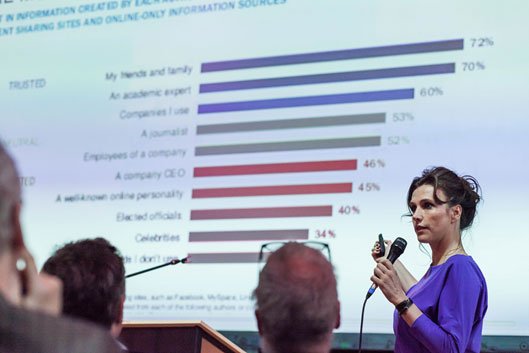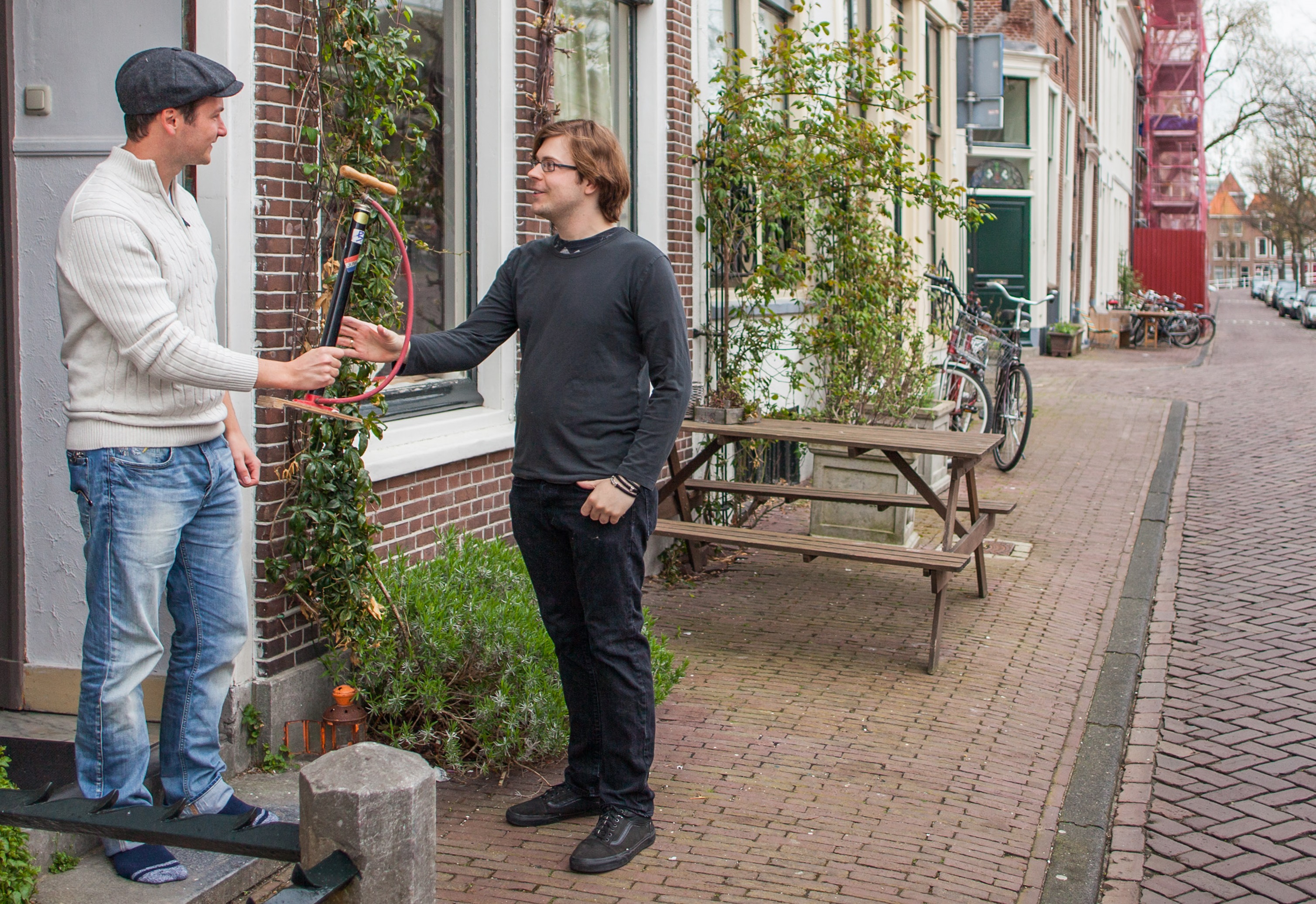The Shire
Scenario 03: Fewer big media, more small websites
What will journalism look like in 2025? To find out, the Journalism Fund developed four potential scenarios for the future. The following is scenario 03. The Shire: A world in which large organisations disappear and more and more citizens organise themselves (do it yourself) and are reluctant to make use of new technology (reluctance.)

The scenarios are based on the input of 150 stakeholders from inside and outside the sector. Read more about how the scenarios came about.
MethodThe government and large media companies are becoming less influential
Citizens and journalists work together in communities. The local region becomes more important
The Shire refers to the region from the book, The Lord of The Rings, where hobbits live in a region full of small medieval villages, are self-sufficient, and care little about what happens in the rest of the world. In this scenario, citizens, attach great value to small-scale, self-reliance and prudence, just like the hobbits in The Shire. They launch their own initiatives rather than being dependent upon a large organisation. The role of government gets smaller and professional journalistic media makes way for a proliferation of community sites.
The trust in government and other large institutions is greatly diminished in this scenario. According to many citizens, the government is insufficiently transparent, does not provide enough dialogue and delivers inadequate services. Also, the government does not do enough to protect citizens against privacy violations by large companies such as Facebook and Google. Additionally, different experiences with cybercrime have fuelled fears of further incidents. As a result, Dutch consumers have become reluctant to make use of internet services.

While confidence in governments and businesses subsides, the confidence of citizens in their fellow man seems to be increasing: borrowing and lending our things, houses and cars to and from one another, even strangers is increasing. Wired analyses how this confidence in the shared economy came into being.
Read moreIn this new world, critical citizens run the show: the consumer acts as a regulator. An increasing number of citizens do not feel connected to society. As a result, the local neighbourhood and region become the new anchor points for the citizen. Privacy, solidarity and care are highly valued, even though it is often difficult to give this any sort of practical form. Extensive cuts by government lead to more and more tasks and responsibilities being handed out to citizens, resulting in a huge growth of citizens' initiatives.
The result of this 'self-organisation' is a strong network and a sharing economy. Insurance is mutually settled, energy is generated and distributed locally, and neighbours provide each other with informal care. There are several digital platforms for the exchange of products and services. You can borrow a tool from your neighbour with apps like Peerby, and you can share car rides with others via platforms like Blablacar and UberPool. Some peer-to-peer networks, such as Bitcoin, even have their own payment system. In more traditional sectors, the power of the citizen is strengthened by the rise of ratings systems: the consumer is able to keep their finger on the pulse via ratings that are provided by others.
The suspicious attitude of consumers towards new technology has ensured that devices are hardly developed further. Televisions, smartphones, tablets, laptops and wearables (gadgets that are worn on the body) still exist. Virtual reality and 3D productions have been developed, but these have not been received warmly by the public. The attention of the industry has shifted from the development of new technology to the optimisation of existing ones. In addition, the safety of technology plays an important role.

Using translation programs, Dutch content can be created worldwide
One technology has seen outstanding development: the translation machine. The advent of advanced translation programs turns the translating and subtitling of foreign productions into a very easy and cheap task. This has major implications for the creative sector: there are multiple global media offerings. In low-wage countries such as India, China and Malaysia, the creative industry is growing especially fast. The Dutch industry, with its relatively high labour costs, therefore does not play a significant role on the international stage.
Falling confidence in large organisations also has a significant effect on the Dutch journalistic landscape. It is hard to persuade consumers into paying for news. Many newspapers, magazines, TV programs and journalists are becoming a part of the establishment, which is not a compliment in this society. Citizens are less and less interested in traditional politics. The issues that people get excited about, are mainly of a local and international character. News is also delivered differently. Increasingly, journalism is practised from one's own particular perspective on the world: Christian, Muslim, or, for example, feminist. Due to falling readership and declining advertising revenue, the business cases for traditional newspapers and magazines no longer exist. As a result, many journalistic titles have been stopped. The television world also has trouble keeping its head above water.

One of the best examples of readers who participate in journalism is Bellingcat. Data, maps and photographs form the basis of the on-line platform where citizen journalists collaborate, for example, to investigate and disclose information about flight MH17.
bellingcat.comA few newspapers and magazines have managed to survive by developing a recognisable profile that attracts a specific group of readers. Readers contribute strongly to journalistic productions: they bring up news topics and participate actively in the journalistic process by, for example, figuring out policy files or writing and producing news (citizen journalism) themselves. News you can use, so-called service journalism, whereby information can be used by the reader immediately, has become an increasingly popular genre.
A large part of the public has now swapped the newspaper for on-line discussions. People organise themselves into on-line communities where they exchange like-minded stories, images and opinions. These free, open forums are seeing an annual increase in participation.
Because of the large numbers of visitors, specific community sites are attractive to local advertisers. The platforms try to generate extra income through sponsorship, donations from members and by organising events. Members may view an ad-free site at a fixed cost. Community sites that pay serious attention to local and regional politics find it difficult to survive because the audience is barely interested in critically tracking the government, whose role has become much smaller.
Because of the large numbers of visitors, specific community sites are attractive to local advertisers. The platforms try to generate extra income through sponsorship, donations from members and by organising events. Members may view an ad-free site at a fixed cost. Community sites that pay serious attention to local and regional politics find it difficult to survive because the audience is barely interested in critically tracking the government, whose role has become much smaller.
The popularity of community sites leads to the increased, direct involvement of citizens. But because the sites often specialise in one theme, the supply of news that is offered becomes splintered. The community news is of a varying quality. In the worst case scenario, they become no more than echo chambers where news and opinions endlessly bounce around, only to be used as confirmation of one being right.

Live streaming by citizen journalists forms a full complement to traditional media, or is it a form of activism? New York Magazine analyses the role of live streaming using the protests in Ferguson as an example.
Read moreThe cost of video and live streaming has fallen, allowing many newspaper, magazine and community sites to stream high-quality images live on their websites. On-line, there is a wide range of regional and local video channels. Linear television only attracts viewers and advertisers for major events. Commercial television providers operate mainly through their own websites and through on-line channels such as YouTube.
The social changes also lead to a new public broadcasting system. Each medium with an editorial charter can qualify for subsidies if they can prove there is a shortage concerning an important social issue. The government also supports a number of major community sites with a professionally trained community manager who moderates, supplements and summarises the discussions.
One part of society becomes lost in the crowded and chaotic world of images and text. It is difficult to determine what is 'true' and whose judgement can be trusted. The knowledge gap is widening throughout society. This gap largely coincides with the divide between highly-educated and low-skilled people. Their 'search strategies' are different; highly-educated people gather news from multiple sources while low-skilled people consult just one or two sources. Making use of filter bubbles enhances this effect.
A filter bubble is a consequence of websites and search engines tuning their results to one's previous on-line search behaviour. This personalisation of search delivers less information that is not consistent with your beliefs or preferences, creating an 'information bubble'.

Experimentation with journalistic consistency
Today, evidence, interpretation and guidance is mainly provided by experts because journalists are mistrusted. Nevertheless, some brands and independent journalists manage to build a strong reputation in the field of investigative journalism. They finance their work through crowdfunding. Various initiatives to grant journalists who meet strict standards of quality with professional accreditation are started, but these never really get off the ground because there is constant debate over who is authorised to grant such approval and the criteria that should be used.
The number of working journalists has decreased dramatically
Employment within webtitles, with a small number of editorial staff and little original content, bears no relation to the number of jobs there were in the media organisations that did not survice. This means that the number of working journalists has decreased dramatically. The growth of community sites also creates new journalistic roles. Some professionally trained journalists work as community managers: they moderate discussions and link people to the platforms.
Fortunately, a small number of independent journalists earn their bread with articles and photos on their own websites or by providing paid contributions to communities. Freelancers earn money by juggling revenue models: besides selling content, they obtain income through crowdfunding, gifts and producing branded content.
Alexander Pleijter, Hogeschool Fontys